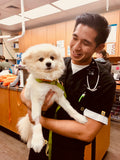It's Saturday morning. your day off from work, you wake up and start your morning routine. You let Nova, your 11 year old mini poodle, out to use the restroom, and go and make some coffee. You finish your cup of joe while watching nova rummage through the bushes as she is apt to do. Next, shower, and let Nova back in. On the way in, you notice Nova bumps into the side of the wall, and realize, that is the fourth time she's done that this week now that you think about it. Additionally, her left eye is squinting a little bit, and starting to tear. Is Nova starting to have some eye issues now that she's getting older? Did the squinting come before or after she ran into the wall? The thoughts are running through your head and you're concerned, luckily, at Wellnergy pets, we have some information for you :)
Let's talk about eye issues, below are some commonly seen eye problems in dogs.
Conjunctivitis
Conjunctivitis is the inflammation of the conjunctiva, which is a thin layer of tissue that lines the inner surface of the eyelid and covering the white part of the eye.There are a variety of reasons why your pet may develop conjunctivitis, such as an allergic reaction, a foreign object such as dust or hair causing irritation to the eye, or even an underlying viral or bacterial infection.
Some clinical signs of conjunctivitis could include redness, inflammation of the eye, and increased discharge that may resemble mucus-like consistency ranging from clear coloration to green or yellow.
It is recommended to bring your dog to your local veterinarian in order to localize the inciting cause of conjunctivitis. Your veterinarian may send you home with some eye medication and/or eye flush/rinse in order to address this common eye problem.
Corneal Damage
The cornea is the most outer transparent part of the eye that covers the pupil, iris, and anterior chamber. It acts as the “outer covering” layer of the eye. Corneal damage is fairly common in our pets, especially a corneal scratch, corneal ulcer, and corneal abrasion. Some common causes can include from physical or chemical trauma such as rubbing eye on carpet, rough play with other dogs/ pets, running through bushes or heavy vegetation, irritating shampoos or environmental debris. There is chance that your pet may have a deep corneal ulcer, which is an indication of a more serious bacterial infection. The bacteria releases substances that degrade the stroma of cornea, which causes the ulcer to progress deeper into the deepest level of the eye (Descemet’s membrane) and can lead to a serious risk of rupture of the eye.
The first sign you may see can include your pet squinting, pawing, or rubbing the eye. Corneal damage can be very painful for your pets, and other symptoms include redness, excess discharge, or tearing.
When you notice initial signs of irritation, bringing your pet to the veterinarian is ideal, as it will give you and your veterinarian to address the concern before it progresses to a corneal ulcer or even a deep ulcer. Many veterinary offices will do some non-invasive diagnostic testing in order to look for a presence of ulcer. They will likely use a special stain called the fluorescein stain, in order to localize the ulcer.If an ulcer is present, your veterinarian is likely send a course of eye medications home for treatment.
Tear Staining
There are a variety of reasons for why your dog may have tear staining! What you may notice a brown, black, or dark red tinge on the fur under his or her eyes. Some reasons may be related to genetics and anatomy, and can be rather harmless processes. such as with dogs that cannot effectively drain the excess tears away due to blocked tear ducts. These tear ducts are located on the inner corner of the eye, which usually drain into the back of the nose and throat. When these ducts are blocked, the pathway of usual drainage is compromised- instead, the eye discharge will spill out of the eye which create the staining under the eye.
Some at-home remedies you can try include purchasing tear stain wipes which will aid in removing tear stains, dried mucus secretions, and other debris that may be present. Wipes can help to reduce the risk of irritation and potential scratching of the eye. Keep in mind that tear stain wipes will likely not resolve the main issue of excess tear staining, however keeping up good hygiene and wiping away tears as needed is still helpful in reducing irritation to the skin underneath the stained areas. Some other causes of excess tears are not so harmless, for example, when your dog’s eyes are irritated, the body produces excess tears. If you can imagine, picture the times you’ve had an eyelash stuck in your eye- wasn’t it just the most irritating thing? One reason why dogs may have tear staining includes constant irritation from fur poking his or her eyes, especially the long-haired breeds such as Maltese, Shih-tzu, Havanese, Poodles, etc. Another factor that can play a role in eye irritation could be the inward-rolling of the eyelids, which is particularly common in short-nosed breeds such as Pugs, Boxers, Bulldogs, or Sharpei. In these cases, practicing good up keeping by regularly grooming your long-haired dog and cleaning the tear stains and/or face rolls as needed are helpful in reducing irritation in the long-run. However, if you feel as if there is no improvement, it is recommended to take your dog to a veterinarian in order to explore the underlying where your dog's tear ducts overproduce tears as mild defect.
There are many other eye issues such as dry eye, glaucoma, cherry eye, cataracts, and even age related vision loss or traumatic eye injuries as Nova had potentially had to deal with. These other conditions generally require further diagnostic testing, and it is recommended to see your regular veterinarian as soon as possible.
While some cases, do require the professional help of a veterinarian, here and Wellnergy Pets, we have designed a holistic supplement formulated by veterinarians to help in preserving the health and function of your pets eyes. Qbow EYE & VISION was developed using natural ingredients such as Mulberry, Cassia, Wolfberry, Dendrobium, Common Yam, and Rehmannia, working together in conjunction to promote circulatory and lacrimal health to reduce excessive tear secretions and staining, preventing and delaying the onset of cataracts, and reduce irritation from dry eyes. Proven components to keep your pets happy and their eyes healthy, because we know just how precious those expressive eyes are.
We hope you’ve found these suggestions to keep your dog's eyes healthy and would love to hear some ways you’re already incorporating! If you have any questions or comments, please feel free to share with us on Facebook, Instagram, below in the comments section, or email us at hello@wellnergypets.com.
About the Author:
 Dr. Zonram Liao D.V.M. is a Southern California native, and earned his undergraduate degree from University of California, San Diego before obtaining his veterinary degree from Ross University School of Veterinary Medicine. He is not only a firm believer in the use of supportive care supplements to improve the health and happiness of his patients, but also is a strong advocate of the benefits of preventive care medicine for his patients as well. During his free time, Dr. Liao enjoys spending his time outdoors fishing and hiking, playing basketball, watching movies, cooking, traveling, and trying new foods.
Dr. Zonram Liao D.V.M. is a Southern California native, and earned his undergraduate degree from University of California, San Diego before obtaining his veterinary degree from Ross University School of Veterinary Medicine. He is not only a firm believer in the use of supportive care supplements to improve the health and happiness of his patients, but also is a strong advocate of the benefits of preventive care medicine for his patients as well. During his free time, Dr. Liao enjoys spending his time outdoors fishing and hiking, playing basketball, watching movies, cooking, traveling, and trying new foods.

